You aim to create user-friendly product pages that focus on converting browsers to buyers. At the same time, you must ensure your product pages are accessible to crawl by search engines. Your product pages are the centerpiece and a key contributing factor to a consumer clicking ‘add to cart.’ The good news is there are actionable strategies you should follow to ensure your products fly off your digital shelves!
Table of Contents
However, effective SEO optimization isn’t all about SEO. Sounds counter-intuitive, right? Let me explain. When optimizing product pages for search, think about user experience. In short, design your product pages with humans in mind, not just Google’s bots! Creating informative, easy-to-navigate, and user-friendly product pages will enhance the shopping experience, sending positive signals to search engines. It’s a win-win.
First things first, let’s look at some of the key statistics when it comes to eCommerce SEO:
- A massive 35% of online searches for products start on Google, making it the most popular search engine for product discovery.
- Nearly half (43%) of eCommerce traffic comes from Google search results pages.
- Nearly half (47%) expect a page to load in two seconds or less (we’ll get to this later!).
- 99% of users only click on a product on the first page of search results.
- According to Baymard, only 48% of the top-grossing US and European eCommerce sites have a ‘decent’ or ‘good’ product page UX performance.
- According to the same survey, none of the websites scored ‘perfect.’
As we know, eCommerce spending is higher than ever. And you need to grab key SEO opportunities, or your competitors will! However, it’s essential to recognize that Google (and other search engines) don’t view each of your product pages in isolation. Instead, they evaluate your entire store. So, before you read our following tips, it’s important to realize you must consider the bigger picture across the rest of your site.
In this guide, we’ll break down key elements of product page SEO and provide ten tips to send you to the top of search results pages.
eCommerce Product Page SEO: 10 Best Practices
As we’ve explored, well-optimized product pages are essential for your eCommerce store. They pull in key, ready-to-convert bottom-of-funnel traffic. So, without further introduction, here are the top 10 product page SEO best practices:
1. Utilize Keywords Effectively
An effective keyword research strategy is the backbone for product page optimization. When starting keyword research for a particular product, zero in on the topics users search for. Relevancy is key.
Remember, product pages typically have transactional intent. This means your landing pages need to be optimized for searchers looking to make a purchase. For instance, a user typing in a detailed query, such as ‘black ergonomic mesh office chair,’ indicates they’re ready to purchase.
Use tools like Google Keyword Planner, SEMrush, or Ahrefs to identify relevant keywords.
Keyword placement is crucial
Once you have your keywords, you must know what to do with them. Make sure to include the primary keyword in your product titles. And incorporate your keywords into your product meta descriptions. This will influence click-through rates from search engine results.
Make sure to include keywords in your product descriptions, too. However, make sure to incorporate them as naturally as possible. In this scenario, balance is critical. Google’s algorithm penalizes keyword stuffing.
Here’s an example from Pimberly customer FurnitureBox. Note how they naturally incorporate keywords and product details into their product description, meta description, and product title.

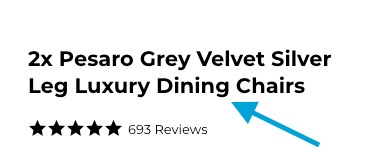
2. Optimize Product Imagery
As we know, eCommerce product page optimization is a crucial step in driving product discovery. Significantly, it also enhances user experience. After all, providing shoppers with a clear and visually appealing impression of your product makes sense.
Remember, your job as an eCommerce marketer is to try to simulate the experience of shopping in a brick-and-mortar storefront. Online shoppers can’t touch or test the product, so high-quality digital assets (images, videos) help fill the gap. However, you must ensure these images and digital assets don’t slow down your product pages.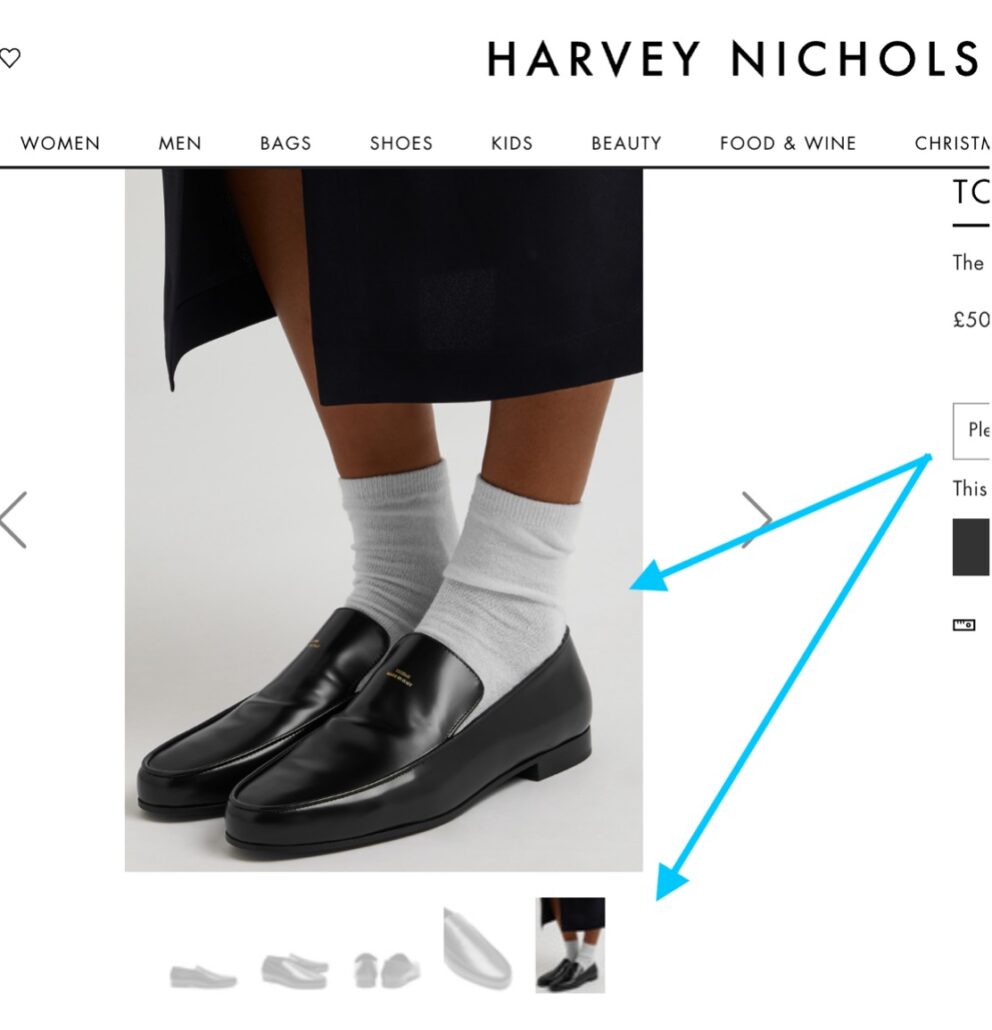
Product Imagery Checklist
There are a lot of variables when it comes to product imagery and SEO product pages. So, to help ensure your product images are optimized according to SEO practices, check off as many of the below points as possible:
- Ensure all images are high-resolution and clear
- Check for proper lighting and color
- Name image files descriptively, reflecting the product accurately
- Include keywords in the file names
- Add concise but descriptive alt text to each image
- Compress images to reduce file size without using quality
- Keep image file size around 100kb to prevent slow page load speeds
- Convert images to WebP format for better performance
- Ensure images display correctly across all devices
- Implement lazy loading so images load as users scroll
- Use tools such as Google PageSpeed Insights to check image performance
3. Mobile Optimization
Mobile eCommerce (‘Mcommerce’) accounts for a huge slice of the market share. In fact, 55.4% of internet users use their mobile phones to shop for products. As eCommerce continues to influence modern retail, mobile eCommerce is growing side-by-side. So, mobile optimization is a pivotal area to invest in.
Mobile browsers expect responsive customer journeys with frictionless checkout experiences. Ensure your website design automatically adjusts to fit the screen size of various devices (smartphones, tablets).
In addition, ensure all buttons, links, and forms are easy to tap and access on a mobile device. Make sure key elements are evenly spaced and not too small.
Regarding the checkout process, minimize the number of steps and required fields. In addition, offer mobile-friendly payment option (Apple Pay, Google Pay). After all your hard work optimizing your online store, you don’t want to lose a customer at the last stage.
4. Accelerate Page Loading Speed
Page speed is a significant ranking factor for search engines. Ultimately, websites that load quickly are more likely to be indexed more efficiently by search engines. This is because fast-loading webpages signal to Google that your website is user-friendly.
As a result, you’ll see increases in revenue and sales, with customers spending more time on your website. Ideally, you want to aim for three seconds or less.
As mentioned previously, image optimization is critical here. However, it’s not the only way to increase the page loading speed. There are lots and lots of tiny things you can do to make your pages run quicker. However, here are the three best ways to accelerate your page load time:
Use a Content Delivery Network (CDN)
A CDN is a network of servers distributed geographically, designed to deliver online content more efficiently. CDNs drastically reduce the distance data travels when a user visits your website, leading to faster loading times.
In addition, by caching content on multiple servers across the globe, CDNs reduce the load on your primary server.
Leverage browser caching
When a user visits your website, elements of the page (images, JavaScript files) are stored in the browser’s cache (temporary storage). The next time the user visits the site, these elements can be loaded from the cache rather than downloaded from the central server again.
Your web server can signal to the browser to keep a cached copy of your website files to use at a future date. Cached resources load much faster because they are retrieved from local storage. This will reduce the page load time, especially for repeat visitors.
Optimize digital assets
In this context, ‘digital assets’ doesn’t just mean images. JavaScript code and CSS stylesheets play a crucial role in the functionality of your online store. If they’re not well-optimized, they negatively impact page load times.
- Streamline JavaScript and CSS: Optimize the size of these files by compressing them. Reducing their size helps your pages to load faster.
- Strategic asset loading: For instance, if your product page features images of related products, they don’t need to load immediately. Utilize ‘lazy loading’ to display these images only after loading the main content. Load the essential elements first, then load additional scripts/styles where needed.
Product page optimization: Part Two
5. User-friendly URL Structure
Make sure URLs are clear, concise, and descriptive. They should make it easier for both users and search engines to understand what your product pages contain. For instance, take these examples from Pimberly customer Footasylum:



The URL incorporates keywords to describe the page’s content rather than just a random string of numbers and letters. This helps in terms of SEO and makes the URL more informative to users.
Here are some specific rules you should stick to:
- In terms of hierarchy and organization, structure your URLs to reflect the hierarchy of your website (e.g., www.example.com/men/shoes/running-shoes)
- Keep URLs short and to the point.
- Use hyphens (-) rather than underscores (_) to separate words in a URL.
- URLs are case-sensitive. Stick to lowercase letters to avoid confusion.
6. Leverage Customer Reviews
Custom reviews and testimonials enhance the credibility of your products. Furthermore, positive reviews act as social proof, boosting conversion rates. In fact, shoppers who visit a product page are 52.2% more likely to convert if the product page has clear and coherent reviews.
In addition, customer reviews keep your products dynamic with regularly updated content. Search engines love this, and you’ll get an SEO boost in the process! Again, it’s another win-win.
Check out this example from Pimberly customer Cotton Traders: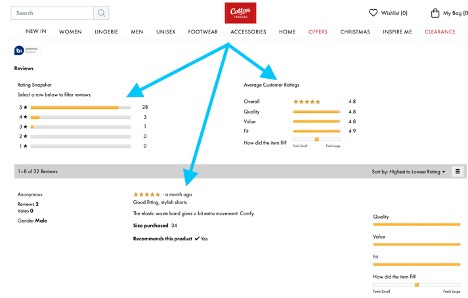
7. Implement Rich Snippets
Rich snippets are created through the use of structured data. They’re enhanced search results, displaying additional information about a product page’s content (ratings, reviews, price, availability). Check out this example from Pimberly customer Footasylum:
Snippets like this are generated by structured data markup. They make your lists more eye-catching in search results, leading to higher click-through rates.
Google’s guidelines on rich snippets can be accessed here.
8. Internal Linking Strategies
To put it simply, links matter! Building links to your home pages and category pages is essential. However, don’t forget to connect your product pages. After all, internal linking is how Google crawls your website and finds all products and pages.
Here are the top 3 ways to implement an internal linking strategy:
-
Link to related products and complementation items
Include a ‘Related Products’ or ‘Customers Also Bought’ section on each product page. This encourages visitors to explore more products, increasing the time spent on your site. It will also distribute page authority across different products, boosting their individual SEO rankings.
-
Implement breadcrumb navigation
Add breadcrumb navigation to all your product pages. Breadcrumbs are a row of internal links at the top or bottom of the page that reflect the site’s architecture. Using Pimberly customer Andertons as an example: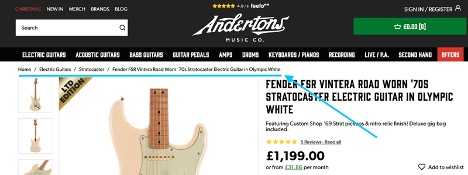
Breadcrumbs enhance user navigation, making it easier for search engines to understand the structure of your website.
-
Optimize anchor text for internal links
Use descriptive, keyword-rich anchor text for internal links. For instance, instead of generic text like ‘click here,’ use specific, keyword-rich descriptions to align with each product. Descriptive anchor text gives users (and search engines!) context about the linked page, boosting your SEO.
9. Regular Content Updates
Regularly updating the content on your eCommerce product pages is a critical practice for SEO. Search engines favor periodically updated content, viewing it as more relevant and up-to-date. Here are some steps you can take to make sure your content is as fresh as possible:
- Revisit and refresh the copy in your product descriptions, incorporating new keywords based on updated SEO research
- Update images and videos with high-quality, current photos
- Ensure your pricing is up-to-date
- Update stock status to reflect availability
- Update meta titles and descriptions for better search engine visibility
- Add new frequently asked questions and answers based on recent customer inquiries
10. Analytics and Performance Tracking
Leveraging the power of analytics is crucial to understanding the impact of your work. Regularly reviewing and acting on data is critical to optimizing your product pages for better results.
Here are some KPIs you should monitor to track the success of your SEO efforts:
Organic traffic
- Measures the number of visitors visiting your product pages from unpaid search results.
- An increase in organic traffic signals an effective SEO strategy.
Bounce Rate
- This is the percentage of visitors who leave your site after viewing a single page.
- Watch out for high bounce rates. High bounce rates signal irrelevant content or poor user experience. Optimizing your product with relevant and compelling product data and digital assets will help prevent customers from bouncing.
Conversion Rate
- The percentage of visitors who complete a desired action (such as making a purchase!)
- Your conversion rate is essential for evaluating the effectiveness of your product pages in driving sales.
Click-Through Rate (CTR) from SERPs
- The percentage of users who click on your site’s link after viewing it in search results.
- Your product title tags, meta descriptions, and snippets are key!
SEO Product Descriptions Explained
As we’ve explored, SEO product descriptions are a core element of your product pages. Well-optimized, keyword-rich descriptions will lead to your products being discovered more frequently in search engines such as Google. In turn, this will result in more sales.
Nevertheless, you can’t just use any keywords in your product descriptions. Strategically incorporating relevant keywords with a high search volume in your product descriptions will capture customers’ intent. Also, well-written and informative product descriptions give customers the knowledge they need to make an informed purchase.
Building credibility and trust will lead to more conversions. Ultimately, you want to create memorable shopping experiences that make them want to shop with you again. Remember, repeat customers are extremely valuable for your business.
Here are some further SEO tips to improve the quality of your product descriptions:
1. Write for people!
Yes, we know how important Google’s algorithm is. However, the golden rule for eCommerce SEO is to write for humans. This might seem counter-productive. But, when ranking your product pages, usability is a significant factor that Google considers.
In addition, you should avoid using the manufacturer-provided descriptions. Your product descriptions should align with your brand tone of voice. You want them to be as unique as possible.
The bottom line: your product descriptions should help potential buyers. When you’ve written a draft, take a step back. Ask yourself: ‘Will this help potential buyers? Is there enough information to give them the confidence to click ‘add to cart’?’
2. Leverage long-tail keywords to capture intent
To find the right keywords, we recommend selecting a keyword tool. These include SEMrush, KWFinder, or Moz Keyword Explorer. By leveraging these tools, research the best keywords to include in your product descriptions.
Keyword research tools will provide you with data about:
- Search volume (how frequently users search for a particular keyword)
- Keyword difficulty (the difficulty of ranking for specific keywords)
- Related terms to potentially use in your product descriptions (long tail keywords)
Nevertheless, long-tail keywords are essential to use in your content. The longer and more specific the search query, the more likely they are to purchase. Long-tail keywords will help target specific search queries, leading to higher conversion rates as they capture users with more defined intent. For instance:
- Women’s waterproof hiking boots size 8
- Organic vegan protein powder chocolate flavor
- Bluetooth noise-canceling headphones over ear
3. Use keywords strategically
So, you’ve done your keyword research, but that’s only one part of the job. Next, you must use them strategically to get the most out of them. And, you need to use them economically. If you stuff your product description with keywords, Google will penalize you.
Here’s where you should use your focus keyword:
- Sparingly in the body copy of your product description (once or twice!)
- Once in the URL
- Once in the alt image description
- Once in the product description title
4. Focus on benefits, not the features
To create an informative and accurate description of a product, you must demonstrate your knowledge from top to bottom. Don’t beat around the bush when describing a product. Instead, present a clear grasp of how the product will improve your customers’ lives.
Check out this example by Dover Saddlery for how to optimize a product page description: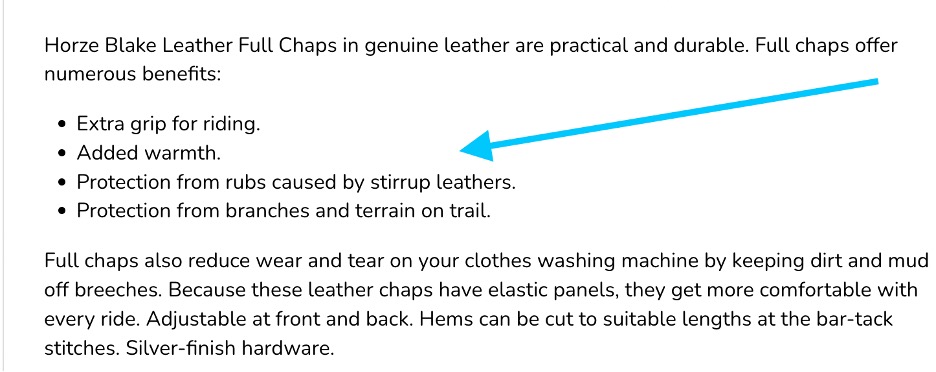
Dover Saddlery’s product description connects more effectively with customers by focusing on benefits. This will lead to more informed purchasing decisions and increased customer loyalty.
The description tells you what the boots are made of (‘genuine leather’), but why should the buyer care? Instead, they break down the benefits of its materials (‘added warmth,’ ‘protection from rubs’). By sticking to the benefits of your products, you’ll persuade more shoppers and boost your SEO in the process.
SEO for eCommerce Product Pages
Successfully optimizing your eCommerce product pages through following SEO best practices is vital to driving traffic and enhancing user experience. In the long run, you’ll see an uplift in sales, and your eCommerce conversion rate will soar.
Key Points
Here’s a round-up of some of the key points we’ve discussed in our blog:
- Developing a comprehensive keyword strategy and incorporating it strategically across your product pages is key to improving product visibility for specific high-intent search queries.
- Remember, good SEO for product pages relies on creating content for humans! Ensure your product content is informative and engaging. Remember, keep it up to date. Google loves fresh content.
- Product descriptions play a crucial role in attracting customers and Google’s crawlers. Write keyword-rich product descriptions, incorporating your keywords as naturally as possible. Avoid simply copy-and-pasting the description provided by the product manufacturer.
- Incorporate long-tail keywords to attract more targeted and high-intent traffic. These keywords are often longer but align closely with search intent, leading to higher conversion rates.
- Take mobile shoppers seriously. Make sure your product pages are mobile-friendly, and you’ll capture even more traffic.
- Fast loading speeds are an essential part of a well-optimized eCommerce store. Compress images using a CDN and minimize the use of heavy scripts to enhance user experience. Responsive websites will result in more happy customers.
- Develop a user-friendly URL structure. Clear, concise, and keyword-rich URLs will help search engines and Google understand your website.
- Include customer reviews on your product pages to provide social proof and enhance trustworthiness. They’re also an easy way to keep your product pages updated without you having to do anything.
- Implementing structured data enables Google to provide rich snippets in search results. Doing so will make your products stand out on SERPs.
- Strategic internal linking will improve site navigation and distribute page authority across your website. A great way to do this is to provide a recommended item section on your product pages!
- Regular updates to product information, prices, and availability are quick and easy ways to ensure your product content is fresh. Google is a big fan of new content, and you’ll give yourself a better chance of ranking higher.
Bottom Line
Keep in mind product page SEO is an ongoing process. You won’t see results overnight. Your SEO strategy requires regular attention and adaptation. Google is constantly fine-tuning its algorithms, and eCommerce trends come and go. It’s essential to stay informed and continuously test and fine-tune your strategy to achieve long-term success.












